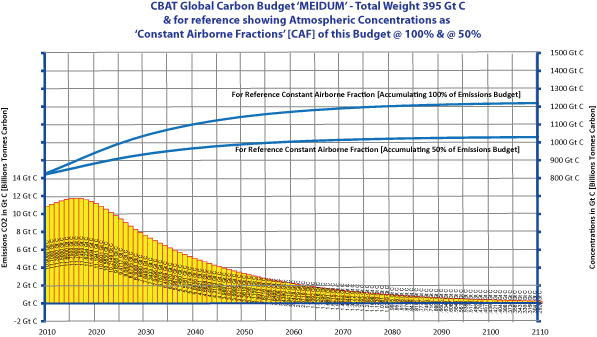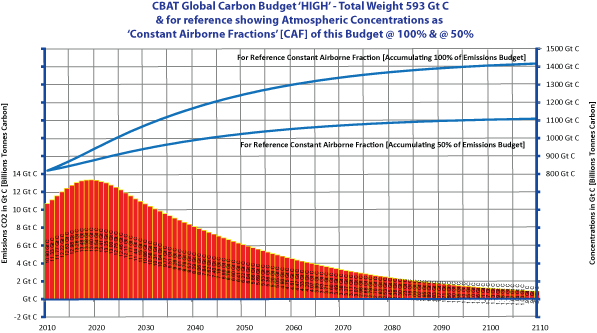What is Contraction and Concentrations?CBAT DOMAIN 1 [D-1]
Contraction & Concentrations & UNFCCC-compliance & CAFAchieving the objective of the United Nations Framework Convention or UNFCCC-Compliance is the purpose of the C&C campaign & CBAT..
Calculations are done with reference to Article 2 or the ‘ultimate objective’ of the United Nations Framework Convention on Climate Change [UNFCCC] which is: -"The stabilization of greenhouse gas concentrations in the atmosphere at a level that would prevent dangerous anthropogenic interference with the climate system. Such a level should be achieved within a time-frame sufficient to allow ecosystems to adapt naturally to climate change, to ensure that food production is not threatened and to enable economic development to proceed in a sustainable manner."
Understanding the relationship between emissions and concentrations is crucial to achieving the objective of the UNFCCC or ‘UNFCCC-compliance’.
Some say the achieving the UNFCCC-objective is merely 'aspirational'. Given the potentially catastrophic consequence of failure, others say it is irrational to even imply failure. Neither attitude spares anyone the need for the relationship between emissions and concentrations to be rationalized.
D-1 is the first and governing Domain of the 4 Domains of the Carbon Budget Analysis Tool [CBAT].
D-1 examines the relationship between various future GHG ‘Carbon-Emissions-Contraction-Events' [Carbon_Emissions-Budgets] and the possible atmospheric-carbon-concentration-Outcomes' of those events.
All CBAT calculations linking carbon-emissions and atmospheric-carbon-concentrations, include the standard conversion [NOAA] where one part per million by volume [PPMV] of atmospheric CO2 weighs 2.13 billion tonnes of carbon [or 2.13 Gt C].
This enables close analysis of the carbon-weight of budget-emissions in Gt C, with the weight of Atmosphere Concentrations in Gt C against a range of future assumptions about the performance of the carbon-sinks.
Atmosphere Concentrations are compared against a 'Constant Airborne Fraction' [CAF] Reference of 100% & 50% of Emissions BudgetsThese are referenced against CBAT's 3 budget-emissions [LOW, MEDIUM, HIGH] at theoretically constant rates of accumulation at 100% and at 50%. This is the convention 'CONSTANT AIRBORNE FRACTION' [CAF]. Establishing, measuring and always showing CAF this way against any 'human-budget' of emissions and alleged rise/fall of concentrations, provides a transparent and clarifying 'frame of reference'.
Doing this makes it immediately possible to see what assumptions about 'sink-efficiency' are being made in whatever climate scenarios are being created. CBAT D-1 makes it possible to clearly measure and compare the 'shape' and 'rate of the emissions-curves with the shapes and rates of concentrations-curves. Without this the relationship may appear to be simply the result of using inscrutable 'black-box' 'climate-models' [such as MAGICC the one behind the UK Climate Act from the UKMO], which one is invited to 'take-on-trust', even though a range of key feedback effects [by their own admission] are still omitted from this model.
Here and below are the three carbon-budgets pre-loaded in CBAT. [Any budget can be inserted and the CBAT model will analyse it].
As most climate-models still omit key and influential 'feedback-effects' continuing to extend this trust seems increasingly inappropriate.
In principle measuring this relationship between emissions and concentrations is straightforward; it is one of stock and flow.
This is much like a filling bath [stock] running a tap from which liquid pours into it [positive flow] and a plug-hole that drains that liquid away [negative flow].In this very simplified ‘bath-analogy’, the: -
- If the tap flows in at the same rate the plug-hole drains away, the bath-level will remain the constant, or
- If the tap flows in at twice the rate the plug-hole drains away, the bath-level will rise at half the rate of the flow from the tap, or
- If the plug-hole drains away at twice the rate of the flow from the tap, the bath-level will fall at half the rate of the drain from the plug-hole.
However, measuring and ‘modelling’ this relationship per unit time is a considerable challenge, since it: -
- goes into a future that ‘hasn’t happened yet’,
- where we don’t have ‘evidence’, we only have ‘trend extrapolation’ of past data into that future, and
- occurs within a large and complex system that we don’t really understand very well even today.
Most feedback-effects are still omitted from the mainstream climate-models. A new approach is needed.Those who have attempted to do this modelling so far, as reported for over twenty years in IPCC Assessments, have persistently failed to include key climate-altering responses from the interactive feedback effects that are consequent on the increased emissions, concentrations and warming that humanity has been causing since industrialisation began around 1880. The UKMO have admitted these omissions from its climate-modelling efforts for example.
The reasons stated for these omissions are ‘difficulty’, ‘complexity’ and ‘uncertainty’. Be that as it may, the key distinction that needs to made and demonstrated in the models, once ‘evidence-based’ ‘science-policy’ modelling is attempted [such as with the UK Climate Act], is between ‘human-budget-emissions’ which we can theoretically control and ‘non-human-feedback-emissions’ which we can’t control and which will increase as the planet warms and melts the permafrost for example.
Faced with these omissions, the modelling community have now been advised by UNEP and even by the IMF that ‘best-guess’ about these omissions ‘is surely not zero’ and that ‘a new approach is needed’.
A new aproach means considering [a] budget-size, [b] emission-type [budget/feedback] against [c] a range of climate-sensitivity values differentiating between: -
CBAT D-1 is an attempt to chart this new approach and to go from there sequentially to CBAT Domains 2-4.
It is clear that everything in the ‘policy-debate’ should be integrated with and governed by a precautionary reading of what is made explicit in this way in CBAT D-1.~~~~~~~~~~~~~~~~~~~~~~~~~~~~~~~~~~~~~~~~~~~~~~~



